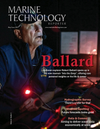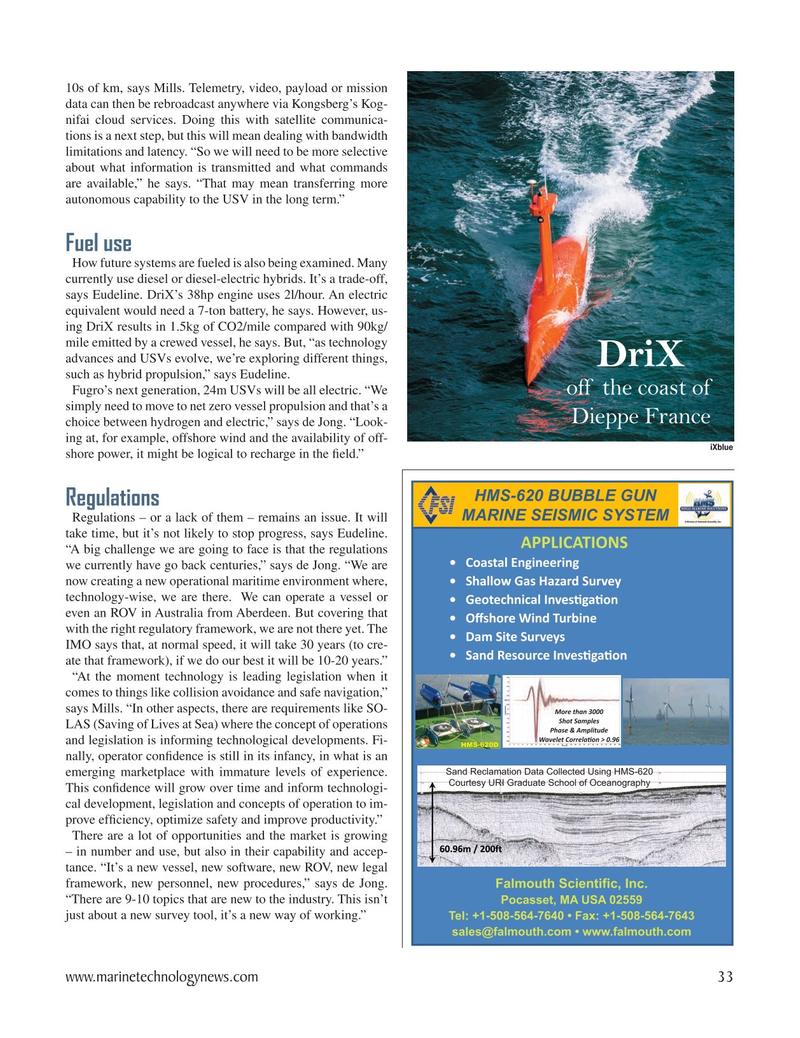
Page 33: of Marine Technology Magazine (May 2021)
Hydrographic Survey Sonar
Read this page in Pdf, Flash or Html5 edition of May 2021 Marine Technology Magazine
10s of km, says Mills. Telemetry, video, payload or mission data can then be rebroadcast anywhere via Kongsberg’s Kog- nifai cloud services. Doing this with satellite communica- tions is a next step, but this will mean dealing with bandwidth limitations and latency. “So we will need to be more selective about what information is transmitted and what commands are available,” he says. “That may mean transferring more autonomous capability to the USV in the long term.”
Fuel use
How future systems are fueled is also being examined. Many currently use diesel or diesel-electric hybrids. It’s a trade-off, says Eudeline. DriX’s 38hp engine uses 2l/hour. An electric equivalent would need a 7-ton battery, he says. However, us- ing DriX results in 1.5kg of CO2/mile compared with 90kg/ mile emitted by a crewed vessel, he says. But, “as technology advances and USVs evolve, we’re exploring different things,
DriX such as hybrid propulsion,” says Eudeline.
Fugro’s next generation, 24m USVs will be all electric. “We off the coast of simply need to move to net zero vessel propulsion and that’s a
Dieppe France choice between hydrogen and electric,” says de Jong. “Look- ing at, for example, offshore wind and the availability of off- iXblue shore power, it might be logical to recharge in the ? eld.”
HMS-620 BUBBLE GUN
Regulations
MARINE SEISMIC SYSTEM
Regulations – or a lack of them – remains an issue. It will take time, but it’s not likely to stop progress, says Eudeline. APPLICATIONS “A big challenge we are going to face is that the regulations ?ŽA?lAuYOsYGG?sYO we currently have go back centuries,” says de Jong. “We are now creating a new operational maritime environment where, ?^SAuuŽ?'A?,A?A?E^??|G?
technology-wise, we are there. We can operate a vessel or ?'GŽlGÐSYsÐAu/Y|G?OOAOŽY even an ROV in Australia from Aberdeen. But covering that ?Ki?SŽ?GtsYEd??dsYG with the right regulatory framework, we are not there yet. The ?Aw^slG^??|G??
IMO says that, at normal speed, it will take 30 years (to cre- ?^AYEZG?Ž??ÐG/Y|G?OOAOŽY ate that framework), if we do our best it will be 10-20 years.” “At the moment technology is leading legislation when it comes to things like collision avoidance and safe navigation,” says Mills. “In other aspects, there are requirements like SO-
More than 3000
Shot Samples
LAS (Saving of Lives at Sea) where the concept of operations
Phase & Amplitude tA|GuGlŽ??GuAOŽY?????
and legislation is informing technological developments. Fi-
HMS-620D nally, operator con? dence is still in its infancy, in what is an
Sand Reclamation Data Collected Using HMS-620 emerging marketplace with immature levels of experience.
Courtesy URI Graduate School of Oceanography
This con? dence will grow over time and inform technologi- cal development, legislation and concepts of operation to im- prove ef? ciency, optimize safety and improve productivity.”
There are a lot of opportunities and the market is growing – in number and use, but also in their capability and accep- tance. “It’s a new vessel, new software, new ROV, new legal framework, new personnel, new procedures,” says de Jong. )DOPRXWK6FLHQWL¿F,QF “There are 9-10 topics that are new to the industry. This isn’t 3RFDVVHW0$86$ just about a new survey tool, it’s a new way of working.” 7HO?)D[
VDOHV#IDOPRXWKFRP?ZZZIDOPRXWKFRP www.marinetechnologynews.com 33
MTR #4 (18-33).indd 33 5/28/2021 3:16:25 PM

 32
32

 34
34
